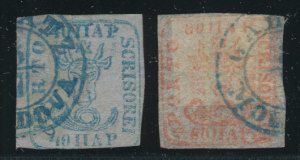Before 1859 Romania didn’t exist in its current form and one of its component nations, Moldavia, was one of the first issuers of stamps. The famous Moldavia Bulls have been a favorite of philatelists since the beginning of our hobby. They combine the three characteristics that collectors most esteem-they were issued for purely postal purposes with no advance warning to collectors and no hoarding. They are primitive in design and execution. And they are, and always have been, rare. A short look at these three philatelic characteristics of popularity will help explain how our hobby developed and cast light on many aspects of philately that are still with us today.
The relationship between stamps’ postal purpose and philatelic issues has always been a confused one in the mind of many stamp collectors. The earliest stamps were obviously always completely non philatelic in origin but by about 1890 the prospect of sales to collectors began to invigorate postal agencies world wide. Collectors yelped in horror (at least in the philatelic writing of the time) as they eagerly bought these stamps for their albums, seduced by the limited nature of the issues and the design appeal. As these limited issues began to increase in price, the deal was sealed. By 1950 it was hard to tell what was issued for postal purposes and what for collectors, even as the era of price rises for philatelic items was largely over.
Philatelists love primitive designs and printing execution. The entire basis for the US one cent 1851-57, a single stamp design that has 14 major Scott numbers ( #5-9 &18-24 ) are minute design differences that were caused by the printers difficulty in properly transferring the stamp die to the plate for printing. There has always been a fascination with printing difficulties and the early stamps of Moldavia, like the Indian States, are among the most primitive and most sought after.
And the last characteristic that philatelists desire in their stamps is rarity. Indeed, where rarity doesn’t exist on its own, collectors restrict the pool to create it. Most of the skills of philatelic specialization are an attempt to make rarer what you need to collect out of a larger, more common pool. The Penny Red of Great Britain specialist has literally millions of stamps to choose from so he looks for rare shades and cancellations and even more refined fractions of these stamps. The Moldavia Bulls have rarity indeed. In fact, just try to find them. We offer only a few per year and the second issue (pictured above) sell for less than $50 each.


